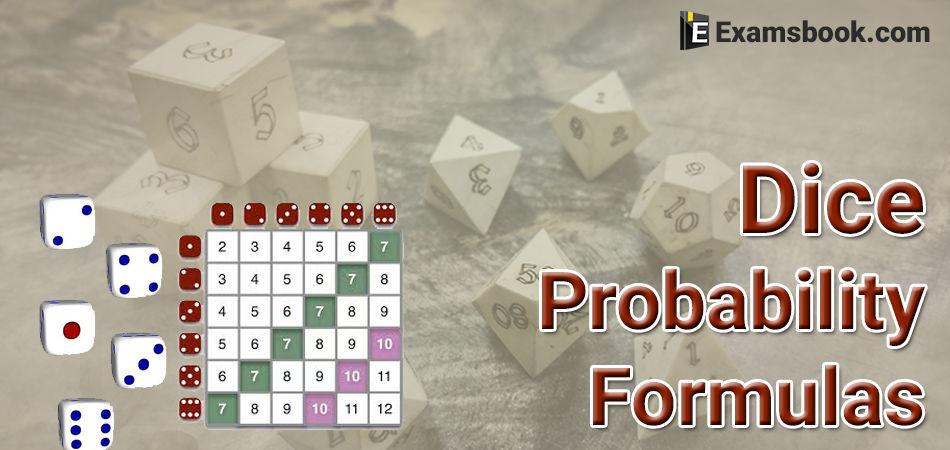Dice Probability Formulas for Competitive Exams

Students face very rare difficulties in the competitive exams who have good reasoning ability to solve reasoning questions. So, here I am sharing you dice probability formulas from which you can improve your mental ability easily.
In this blog, you can understand how to use formulas in dice questions to solve dice problems. So, start your practice with these questions to understand using formulas as well as. You can more practice with Dice Problems in Probability for a better rank in competitive exams.
Formulas of Dice Probability Questions
Single Dice -
When a single die is thrown, there are six possible outcomes: 1, 2, 3, 4, 5, 6.
The probability of any one of them is 1/6
Probability
Probability of an event happening = Number of ways it can happen / Total number of outcomes
Example.1: the chances of rolling a "4" with a die.
Solution:
Number of ways it can happen: 1 (there is only 1 face with a "4" on it)
Total number of outcomes: 6 (there are 6 faces altogether)
So the probability = 1/6
Probability for Rolling Two Dice
Probability for rolling two dice with the six sided dots such as 1, 2, 3, 4, 5 and 6 dots in each die.
When two dice are thrown simultaneously, thus number of event can be 62= 36 because each die has 1 to 6 number on its faces. Then the possible outcomes are shown in the below table.
Probability – Sample space for two dice (outcomes):
|
|
1 |
2 |
3 |
4 |
5 |
6 |
|
1 |
(1,1) |
(1,2) |
(1,3) |
(1,4) |
(1,5) |
(1,6) |
|
2 |
(2,1) |
(2,2) |
(2,3) |
(2,4) |
(2,5) |
(2,6) |
|
3 |
(3,1) |
(3,2) |
(3,3) |
(3,4) |
(3,5) |
(3,6) |
|
4 |
(4,1) |
(4,2) |
(4,3) |
(4,4) |
(4,5) |
(4,6) |
|
5 |
(5,1) |
(5,2) |
(5,3) |
(5,4) |
(5,5) |
(5,6) |
|
6 |
(6,1) |
(6,2) |
(6,3) |
(6,4) |
(6,5) |
(6,6) |
Note:
(i) The outcomes (1, 1), (2, 2), (3, 3), (4, 4), (5, 5) and (6, 6) are called doublets.
(ii) The pair (1, 2) and (2, 1) are different outcomes.
Dice Problems in Probability Solved Example with Solution :
Example.1. Two dice are rolled. A is the event that the sum of the numbers shown on the two dice is 5, and B is the event that at least one of the dice shows up a 3.
Are the two events (i) mutually exclusive, (ii) exhaustive? Give arguments in support of your answer.
Solution:
When two dice are rolled, we have n(S) = (6 × 6) = 36.
Now, A = {(1, 4), (2, 3), (4, 1), (3, 2)}, and
B = {(3, 1), (3, 2), (3, 3), (3, 4), (3, 5), (3, 6), (1,3), (2, 3), (4, 3), (5, 3), (6, 3)}
(i) A ∩ B = {(2, 3), (3, 2)} ≠ ∅.
Hence, A and B are not mutually exclusive.
(ii) Also, A ∪ B ≠ S.
Therefore, A and B are not exhaustive events.
Example.2. Two dice are rolled. Let A, B, C be the events of getting a sum of 2, a sum of 3 and a sum of 4 respectively. Then, show that
(i) A is a simple event
(ii) B and C are compound events
(iii) A and B are mutually exclusive
Solution:
Clearly, we have
A = {(1, 1)}, B = {(1, 2), (2, 1)} and C = {(1, 3), (3, 1), (2, 2)}.
(i) Since A consists of a single sample point, it is a simple event.
(ii) Since both B and C contain more than one sample point, each one of them is a compound event.
(iii) Since A ∩ B = ∅, A and B are mutually exclusive.
You can ask me anything related dice probability formulas in the comment section without any hesitation. Visit on the next page for more practice.



